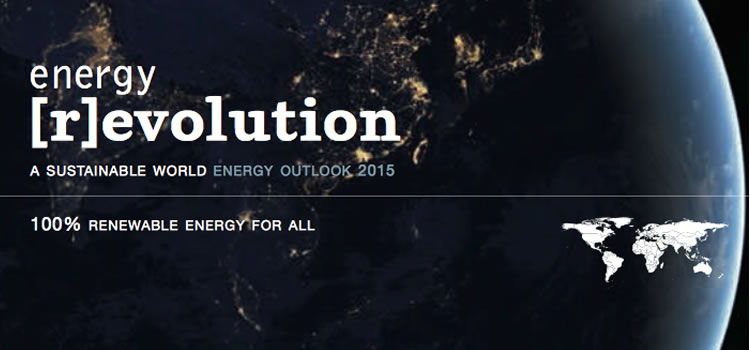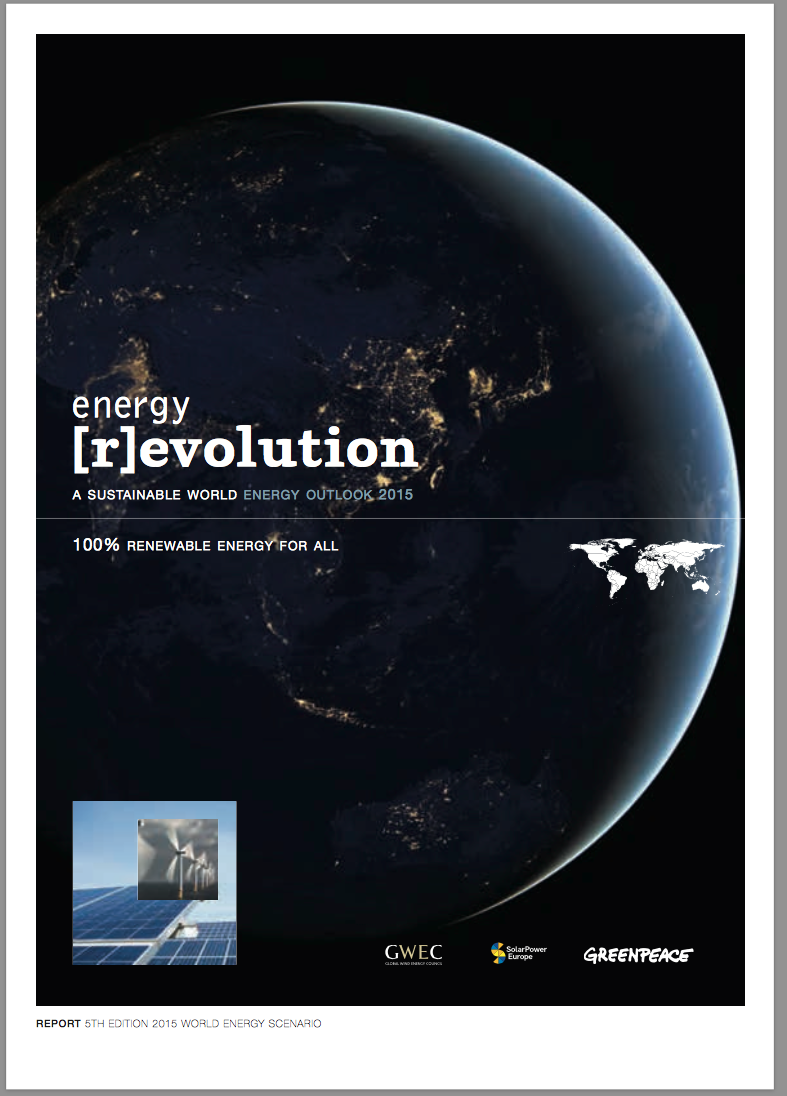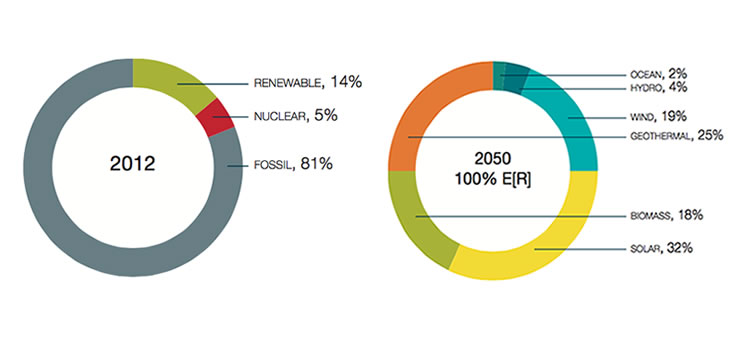Rapport Greenpeace: in 2050 kan de hele wereld fossielvrij zijn

21 september 2015 – ‘This is the year when the fight against climate change could take a dramatic turn.’ Kort voor de Klimaattop in Parijs presenteert Greenpeace haar nieuwste transitie-scenario. In 2050 fossielvrij kán.
Uit een bericht van NRC Q
‘(…) Over 35 geen olie en gas meer. Het kan, zegt Greenpeace. (…) Dat schrijft de Volkskrant op basis van een energiescenario van Greenpeace. De omwenteling is duur, geeft Greenpeace toe. Om wereldwijd van kolen, gas en olie af te komen, kost 64.600 miljard Amerikaanse dollar. Dat geld moet vloeien naar het ontwikkelen van alternatieve energiebronnen, als zon, wind en aardwarmte. Kernenergie is voor Greenpeace geen optie. Stroom duurzaam opwekken is volgens het scenario haalbaar. Een stuk moeilijker zal het zijn om schepen, vrachtwagens en vliegtuigen duurzaam te laten voortbewegen. (…)’
 Volkskrant: ‘Gas en olie in 2050 verleden tijd’
Volkskrant: ‘Gas en olie in 2050 verleden tijd’
De Volkskrant doet verslag van het vanmorgen gepubliceerde Energy [R]evolution report. Het is de nieuwste update van de eerste editie die tien jaar geleden verscheen.
Punten die de Volkskrant uit het rapport haalt:
- Binnen 35 jaar afscheid nemen van kolen, gas en steenkool: het kan.
- Gaat niet ten koste van de economie (zonne- en windenergie leveren alleen al meer banen op dan de kolenindustrie).
- De omslag is wel duur: wereldwijd 64.600 miljard dollar aan investeringen nodig.
- ‘(…) De investeringen bedragen wereldwijd 1.660 miljard dollar per jaar, maar daar staat volgens het scenario een besparing op brandstof tegenover van 1.100 miljard. Uiteindelijk worden de kosten in 2050 zelfs ruimschoots gedekt door toekomstige besparingen op fossiele brandstoffen, en de kosten die uit het gebruik daarvan zouden voortvloeien. (…)’
- De nieuwste editie van het rapport is optimistischer over 100% duurzame energieopwekking, doordat de kosten voor zonne- en windenergie sterker zijn gedaald dan verwacht.
- Zware industrie zal ingrijpend veranderen.
- Kernenergie doet in het Greenpeace-scenario niet mee
- Biomassa wel
- Aardwarmte wordt heel belangrijk. In Europa zerlfs de belangrijkste energiebron.
- Vrachtauto’s, zeeschepen en vliegtuigen zijn voor het Greenpeace-scenario de lastigste onderwerpen en vergen een technische revolutie.
- De overschakeling van het personenvervoer op elektrisch kan tamelijk makkelijk.
Eerste commentaren
De Volkskrant vroeg ir. Jan Paul van Soest (adviesbureau De Gemeynt) en prof. dr. Coby van der Linden (Clingendael International Energy Programme) om een eerste reactie.
Van Soest noemt de analyses grondig, maar hij noemt ze ook ‘vooral technisch’. Lang niet alles wat technisch mogelijk is, is volgens hem in de praktijk ook realiseerbaar. Hij vindt het ook jammer dat Greenpeace zich niet afzet tegen economische groet.
Van der Linden noemt de scenario’s ook ‘goed’. Ze vindt de Greenpeace-scenario’s wel erg optimistisch over energiebesparing en ook is ze er niet zo zeker van of de prijzen voor fossiele energie wel zullen stijgen.

Eigen samenvatting van Greenpeace
Uit de eigen toelichting van Greenpeace
‘(…) The scenario outlined in the latest Greenpeace Energy [R]evolution report would mean the world would stay within the IPCC’s 1,000 gigatonne “carbon budget” and prevent the worst catastrophes of climate change from happening. It envisions global emissions peaking at the end of this decade, a return to 1990 levels in 2030, a 60% reduction by 2040 and near zero emissions in 2050 (discounting non-energy sectors such as steel).
According to lead author Sven Teske, not only is it possible to completely decarbonise the global power sector by 2050, it can be done at no extra expense — because of all the fuel cost savings.
Heating is more complicated, but still feasible since there’s a huge number of potential efficiencies. Considerable capital would have to be devoted to developing renewable heating technologies such as enhanced geothermal and solar arrays.
Decarbonising transport is tricky as well, but can largely be achieved by growing and electrifying public transports like trains, as well as encouraging the uptake of ever-improving electric vehicles.
And with this clean energy global infrastructure in need of constructing, there would be many millions of jobs going — as many as 9.7 million working in solar PV alone in 2030.
This analysis arrives less than three months before the UN is due to meet in Paris to hash out a global agreement on climate change. The report says a strong deal — in which country commitments are reassessed every 5 years — is integral to getting to 100%.
There’s a pretty well-known scientific consensus that any more global warming than two degrees celsius will trigger the most extreme consequences of climate change.
To wit, the IPCC has said that any more than 1,000 gigatonnes of carbon dioxide emissions will ensure we cross that threshold.
And according to the International Energy Agency (IEA), should the world continue with “business-as-usual”, it will use up that “carbon budget” by 2040, and annual emissions will increase 56% by the middle of the century.
But the Energy [R]evolution report, which Teske has previously characterised as a “work plan”, has a detailed scenario in which the global energy transition is achieved in the next 35 years.
To get to 100% renewables, naturally we would need a lot more renewables than we have now. Where currently they provide 21% of the world’s electricity, renewables could produce up to 64% in just 15 years — and way more than that thereafter.
The sector is already trending upwards in a big way, with renewables representing 60% of new power around the world in 2014.
Accusations levelled at reports like this are often cost-centric and, admittedly, the 100% scenario would require an average additional investment in renewables of $1 trillion a year.
But, because renewables don’t require fuel, there also are savings on that front — about $1 trillion a year, in fact.
So while electricity supply costs around the world would likely double by 2050 to $5.35 trillion, they would hit $6.2 trillion under the [R]evolution plan — with that extra trillion offset by fuel cost savings.
And looking beyond 2050, there’s further advantages in the renewables agenda: meeting emissions targets and stabilising energy costs thereafter.
It’s actually fairly straightforward for electricity; about 95% of investment must go towards renewables and cogeneration.
By 2030 the only “fossil fuels as power” spending should be on gas plants set to switch from natural gas to renewable hydrogen in the years following.
Subsidies for fossil fuels, which the International Monetary Fund (IMF) says equal $5.3 trillion a year, should be removed in the next few years, some going instead to support the insurgent renewables economy.
While the IEA “current policies” scenario says the number of energy jobs will increase until 2020 at which point it’ll fall, the Energy [R]evolution report foresees energy employment steadily rising over the years.
The solar sector will lead the way, with the report claiming it will employ 9.7 million people by 2030 — as many as coal does today.
But wind isn’t far behind, with the number of jobs on offer increasing tenfold in the next 15 years — from 700,000 today to 7.8 million. That’s twice as many as oil and gas.
Overall, a 25% increase by 2020 will become 60% in 2025 and reach a monumental 48 million jobs in 2030.
But in heating and transport, which are harder to decarbonise than electricity, there are a few important steps that must be taken to achieve that 100% renewable. For the former, it’s a lot about efficiency. In fact, looking more broadly, there are so many potential energy efficiencies that demand in 2050 could be as much as 15% less than it is today. So with energy efficiency accounting for 33% of heat demand in 2050, the rest is made up of a portfolio of renewable heating (which can do 43% by 2030) and biomass, which represents an enormous majority of the 21% heat renewables currently provide.
The report says $429 billion a year will be required to do all that, plus developing preferable renewable heating options such as solar thermal.
And transport is a little more vague. It counts on governments incentivising the use of smaller, more energy efficient vehicles.
Renewables-powered trains and buses should be deployed all over the place — but particularly cities — since there’s potential energy savings of up to 62% on that front.
Couple that with a proper proliferation of hybrid and electric cars, which together could boost the decarbonisation of road transport from practically nothing now to 14% in 2030 to more than half in 2050.
And there you have it — 100% renewables in a generation or so. (…)’
Bronnen
De Volkskrant, 21 september 2015: ‘Gas en olie in 2050 verleden tijd’ (via Blendle)
NRC Q, 21 september 2015: Over 35 geen olie en gas meer. Het kan, zegt Greenpeace
Greenpeace (international), 21 september 2015: Here’s how the world can get to 100% renewable energy
Greenpeace (international), downloadpagina rapport, samenvatting, ‘key messages’: Energy Revolution 2015
Persbericht Greenpeace, 21 september 2015: 100% Renewable Energy for all



